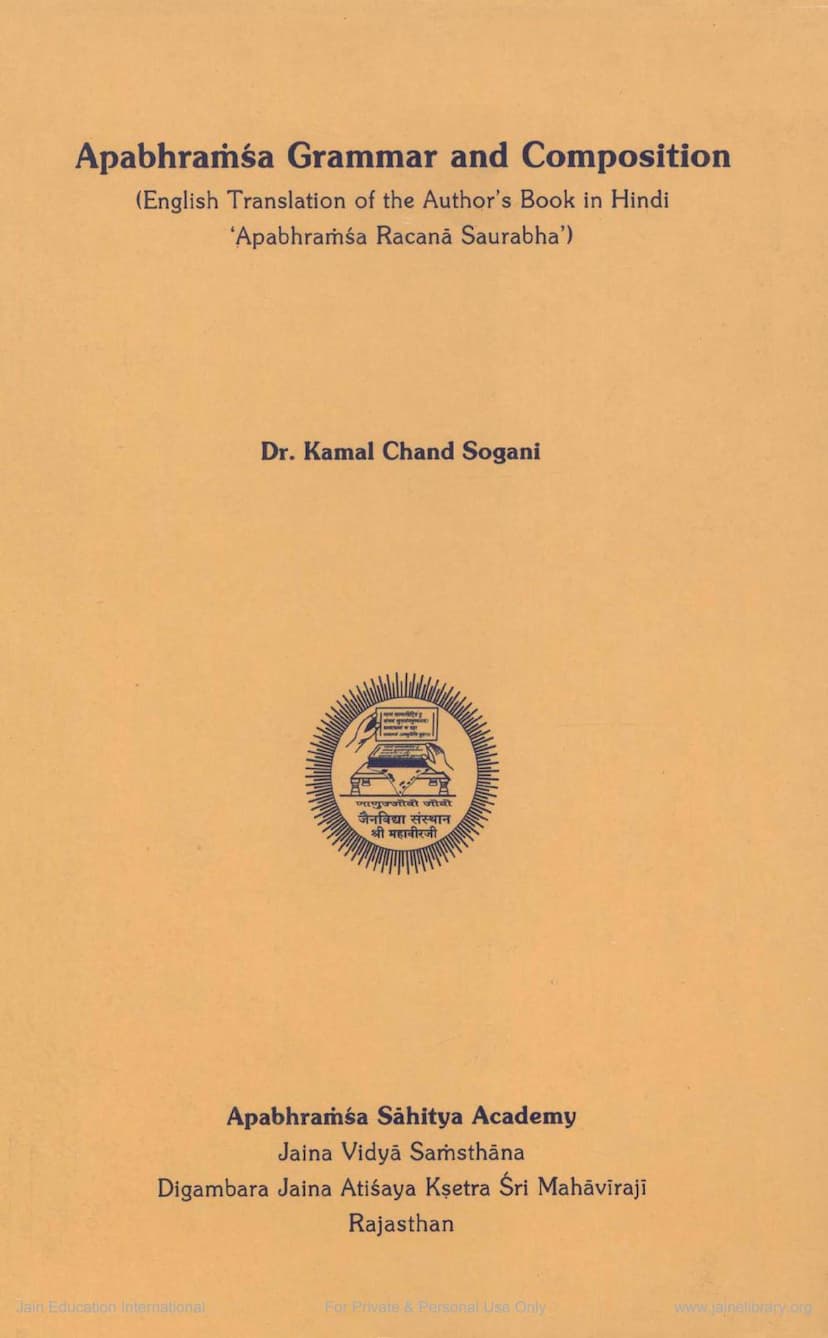Apbhramsa Grammar And Composition
Added to library: September 1, 2025

Summary
Here's a comprehensive summary of the Jain text "Apabhramsa Grammar and Composition" by Dr. Kamal Chand Sogani, based on the provided table of contents and introductory pages:
Book Overview:
"Apabhramsa Grammar and Composition" is an English translation of Dr. Kamal Chand Sogani's Hindi book, "Apabhramsa Rachana Saurabha." Published by the Apabhramsa Sahitya Academy, Jaina Vidya Samsthāna, Digambara Jaina Atiśaya Kshetra Sri Mahaviraji, Rajasthan, this book serves as a comprehensive guide to understanding and learning the Apabhramsa language.
Significance of Apabhramsa:
The book highlights the importance of Apabhramsa as a rich Indo-Aryan language that evolved from Prakrta. It emphasizes that Prakrta was the mother tongue of Mahavira and Buddha and that Apabhramsa, in turn, became the lingua franca of Northern India by the 6th century AD. Apabhramsa is credited with giving birth to many modern Indian languages, including Hindi, Sindhi, Punjabi, Marathi, Bengali, Gujarati, Kashmiri, Maithili, Rajasthani, and Odia. Understanding Apabhramsa is crucial for comprehending the development of Hindi literature.
Establishment of the Academy:
Recognizing the cultural significance of Apabhramsa, the Digambara Jaina Atiśaya Kshetra, Shri Mahaviraji, established the Apabhramsa Sahitya Academy in 1988 to promote its study. This English translation aims to facilitate the learning of Apabhramsa for English-speaking students.
Content and Structure:
The book is structured into 84 lessons, covering various aspects of Apabhramsa grammar and composition. The table of contents reveals a systematic approach to learning the language, beginning with foundational elements and progressing to more complex structures.
Key Grammatical Topics Covered:
The book systematically introduces and explains the following key grammatical concepts:
- Pronouns: Extensive coverage of pronouns in singular and plural forms, across all three persons.
- Verbs: Detailed explanation of intransitive and transitive verbs, including:
- Tenses: Present, Past (using past participles), Future, and Imperative tenses are thoroughly covered.
- Voice: Active and Passive voices are explained, with specific lessons dedicated to their construction.
- Moods: Obligatory and Potential moods are discussed.
- Special Verbal Forms: Absolutive and Infinitive forms are explained with their usage.
- Causative Verbs: Suffixes and constructions for causative verbs are detailed.
- Impersonal Forms: The use of verbs in impersonal forms is explored, particularly for intransitive verbs and past participles.
- Nouns:
- Gender: Masculine, Feminine, and Neuter genders are discussed.
- Declension: Comprehensive coverage of noun declensions across various cases (Nominative, Accusative, Instrumental, Dative, Genitive, Ablative, Locative, Vocative) and numbers (Singular and Plural).
- Noun Endings: Focus on nouns ending in '-a', '-i', '-u', and '-å'.
- Word Classes: Discussion of Indeclinables.
- Conjugation: Detailed conjugation of verbs, including the common verb 'Asa' (to be).
- Numerals: Declension of cardinal numerals.
- Participles: Explanation of Present, Past, Obligatory/Potential, and Causative participles and their various uses.
- Suffixes: Explanation of various grammatical suffixes.
- Svarthika Suffixes: Discussion of suffixes that retain the innate meaning of nouns.
- Exercises: Each grammatical section is followed by exercises for practice and reinforcement.
- Indexes: The book includes comprehensive noun and verb indexes for easy reference.
Pedagogical Approach:
The book adopts a structured, lesson-by-lesson approach, building grammatical knowledge progressively. It starts with simple sentences and gradually introduces more complex grammatical structures, verb conjugations, and noun declensions. The inclusion of numerous examples and exercises facilitates practical application of the learned concepts.
Overall:
"Apabhramsa Grammar and Composition" by Dr. Kamal Chand Sogani is a valuable resource for anyone seeking to learn the Apabhramsa language. Its detailed explanations, systematic structure, and practical exercises make it an accessible and effective tool for both self-study and classroom instruction. The book not only delves into the grammatical intricacies of Apabhramsa but also underscores its historical and cultural importance within the Indian linguistic tradition.